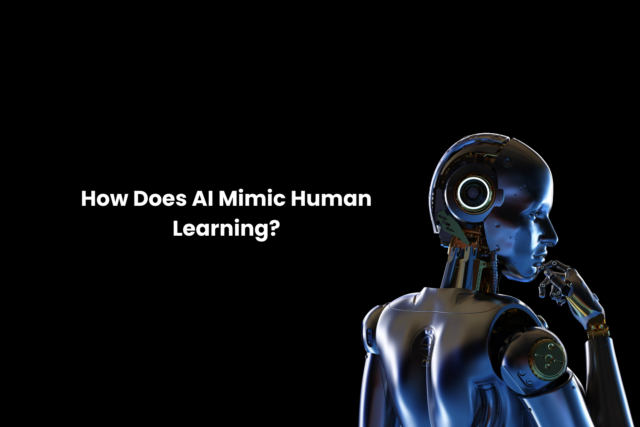
Artificial Intelligence And Machine Learning Training have made it feasible for us to interact with robots in new ways. One of its distinguishing features is AI’s ability to simulate human learning processes. This blog will examine how artificial intelligence (AI) replicates human cognition in tasks like learning and decision-making. Let’s explore AI’s internal mechanisms to learn How Does Artificial Intelligence Work.
What Is The Process of Artificial Intelligence?
Table of Contents
Creating intelligent computers and gadgets is the main objective of AI research and development. These duties require decision-making, reasoning, problem-solving, language understanding, and pattern identification.
The primary components of artificial intelligence may be separated, with many requiring machine learning:
Systems for artificial intelligence start with a large-scale data-collecting process. Depending on the objective, text, images, videos, or sensor inputs, this data might be.
Raw data is often messy and unstructured. Preprocessing involves organising, transforming, and cleaning data so the AI system can utilise it.
For many uses of AI, not all data is usable. Which features of a dataset are most helpful for a particular learning activity are identified via feature extraction.
An AI system’s machine learning algorithms are its fundamental components. These algorithms draw conclusions, make predictions, and allocate categories based on the cleaned and prepared data. Conventional machine learning techniques include reinforcement, unsupervised, and supervised learning.
During their training stages, artificial intelligence (AI) systems are fed either labelled data (for supervised learning) or unlabeled data (for unsupervised learning). The algorithm continuously modifies its internal parameters to lower error or raise reward after learning from the input data.
After training, the AI is assessed with new, untested data. Efficient application of training set knowledge to untrained input is a critical metric for evaluating a system’s quality.
An AI system often returns its operational results to improve overall system performance. This continuous learning process allows Artificial intelligence to react to new situations and information.
Emulating Human Inquiry
After reviewing the basics of AI, let’s look more closely at how it emulates human learning:
Pattern Identification: Humans must first learn to identify patterns in data to do numerous tasks involving learning, such as language comprehension and facial recognition. Artificial intelligence (AI) employs machine learning techniques like neural networks to find intricate data patterns to complete tasks like photo recognition and natural language processing.
Modification and Enhancement: Because they can learn and adapt, humans can change. AI systems that use reinforcement learning can learn from their errors and improve their decision-making in response to positive and negative feedback. AI’s ability to learn from real-world driving situations is crucial for autonomous automobiles, which greatly illustrates this ability in action.
Transference of Learning: The capacity to generalise knowledge from one domain to another is a special talent of humans. AI makes considerable use of transfer learning, which enables models optimised for one job to be applied to another. This type of efficiency is required for speech recognition and language translation.
Interpretation of Natural Language: One measure of human intelligence is the capacity to understand spoken language. With deep learning techniques and large language models, artificial intelligence (AI) systems have made significant strides in understanding and producing human-like text, opening the door for chatbots, virtual assistants, and language translation services.
Thinking and Making Decisions: Humans use reason and logic to solve problems and make decisions. Systems using artificial intelligence (AI), particularly those focusing on knowledge representation and symbolic AI, aim to mimic human cognitive capacities. These sorts of systems are used in two different fields: expert systems and medical diagnostics.
The Functions of Machine Learning and Artificial Intelligence Training
AI systems have the potential to mimic human learning, but they still need to be developed and used with expert knowledge and expertise. Machine learning and artificial intelligence training programmes are essential for preparing employees to work with AI technology.
Here’s how training courses enhance knowledge about artificial intelligence and its advancements:
Trainees may choose the machine learning algorithms most suited to finish a certain task by understanding the ins and outs of various algorithms.
In AI classes, ethics and ethical AI development are often covered. Students’ capacity to recognise and respond to ethical issues with artificial intelligence is enhanced.
By taking part in projects and activities that put theory into practice, individuals may apply what they learn in training courses to real-world applications of artificial intelligence. Getting real-world experience is essential to become an expert in AI.
Numerous AI education initiatives encourage interdisciplinary research by uniting experts from other fields to collaborate on challenging AI problems.
In summary
Artificial Intelligence Training plays a pivotal role in harnessing the potential of artificial intelligence, which has brought significant technological advancements by emulating human cognitive capabilities. Understanding the internal mechanisms of AI and how it replicates human learning is paramount in maximizing its potential.
AI and ML training equip participants with the necessary knowledge and skills to develop and deploy morally responsible AI systems. As AI continues to transform numerous industries, it becomes increasingly vital for knowledgeable specialists to ensure that AI systems are not only efficient but also ethically secure. Therefore, investing in AI training is not just an opportunity but a necessity to navigate the evolving landscape of technology and ethics in the AI-driven world.














































